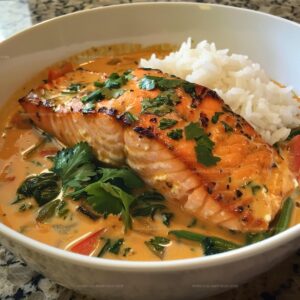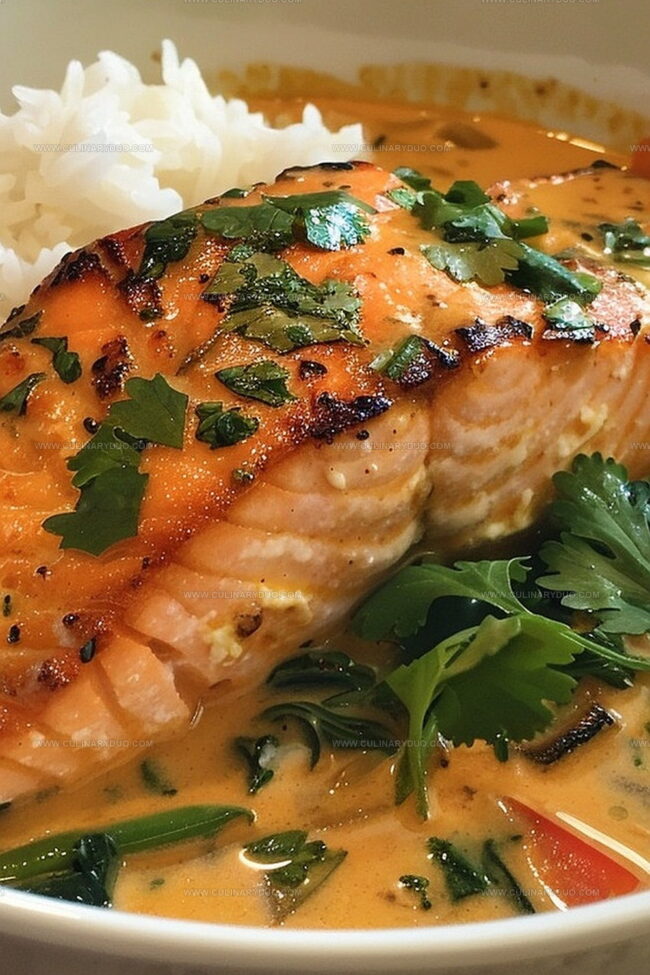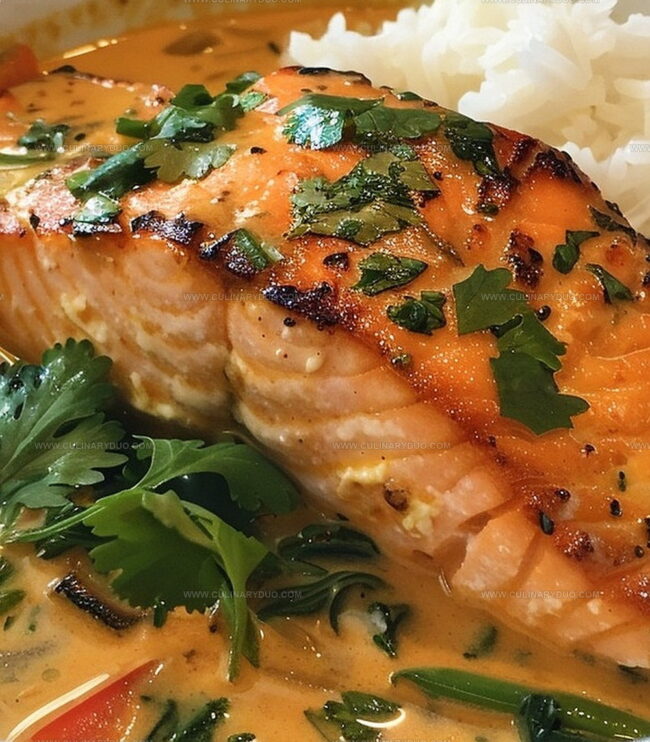Dreamy Thai Coconut Salmon Curry Recipe: Taste Paradise Now
Creamy, aromatic currents of flavor swirl through this tantalizing thai coconut salmon curry recipe that promises a culinary adventure.
Tender salmon nestles in a velvety coconut sauce bursting with exotic spices and vibrant herbs.
Each spoonful brings a harmonious blend of richness and zest that dances across your palate.
Fresh ingredients combine to create a meal that feels both comforting and exciting.
Fragrant lemongrass and ginger infuse the sauce with depth and complexity.
Vibrant vegetables add color and nutrition to this stunning dish.
Thai Coconut Salmon Curry Overview
Ingredients for Thai Coconut Salmon Curry
Proteins:Aromatics and Vegetables:Spices and Seasonings:Liquids and Binding Ingredients:Herbs and Finishing Touches:Cooking Fats:Preparation Instructions for Thai Coconut Salmon Curry
Step 1: Prepare Salmon
Pat salmon fillets completely dry using paper towels.
Generously season the fish with salt, black pepper, and sweet paprika, ensuring even coverage across the entire surface.
Step 2: Create Golden Crust
Heat a blend of coconut oil and butter in a large non-stick pan over medium-high heat.
Carefully place salmon fillets into the hot pan.
Sear each side for 3-4 minutes until a beautiful golden-brown crust forms.
Gently remove salmon and set aside on a clean plate.
Step 3: Build Flavor Base
In the same pan, add:Cook on low heat for 2 minutes until aromatic.
Toss in chopped bell peppers and sauté for an additional 3 minutes.
Stir in tomato paste and curry paste, cooking for 1 minute.
Sprinkle ground coriander, cumin, and red pepper flakes.
Season with salt and pepper.
Pour in broth and bring to a rolling boil.
Step 4: Create Creamy Curry Sauce
Add to the pan:Stir ingredients thoroughly.
Pour in coconut milk and reduce heat to create a gentle simmer.
Step 5: Finish Cooking Salmon
Carefully nestle seared salmon fillets into the simmering sauce.
Squeeze fresh lemon juice over the fish.
Allow to simmer for 3-5 minutes until salmon is perfectly cooked and sauce slightly thickens.
Remove from heat.
Step 6: Garnish and Serve
Fold in fresh basil leaves.
Serve immediately over steamed rice or alongside crusty bread.
Sprinkle extra red pepper flakes for added heat.
Enjoy your restaurant-quality meal!
Pro Tips for Thai Coconut Salmon Curry
Flavor Variations for Thai Coconut Salmon Curry
Serving Ideas for Thai Coconut Salmon Curry
Storage Tips for Thai Coconut Salmon Curry
FAQs
Wild-caught or Atlantic salmon are great choices. Look for fresh, high-quality fillets with firm flesh and no strong fishy smell.
Absolutely! You can substitute salmon with chicken, shrimp, or tofu if you prefer. Adjust cooking times accordingly to ensure proper doneness.
The spice level depends on the curry paste you use. Red curry paste tends to be spicier, while green or yellow are milder. You can control heat by adding more or less red pepper flakes.
No special equipment required. A large non-stick frying pan and basic kitchen tools like a knife and cutting board are all you’ll need to create this delicious curry.
Print
Thai Coconut Salmon Curry Recipe
- Total Time: 30 minutes
- Yield: 4 1x
Description
Savory Thai Coconut Salmon Curry promises an exotic culinary journey through Southeast Asian flavors. Delicate salmon nestles in a creamy, spice-infused coconut sauce, inviting you to explore a perfect balance of rich and fresh ingredients.
Ingredients
Protein:
- 4 salmon fillets (skin removed)
Vegetables and Aromatics:
- 1 red bell pepper (finely chopped)
- 1 baby Bok choy (roughly chopped)
- 1 small onion (finely chopped)
- 4 garlic cloves (minced)
- 1 tablespoon (tbsp) grated ginger
Liquids and Sauces:
- 2 tablespoons (tbsp) coconut oil or vegetable oil
- 1 tablespoon (tbsp) unsalted butter
- 1 ¾ cups unsweetened coconut milk (full fat)
- ½ cup vegetable broth
- 3 tablespoons (tbsp) Thai red curry paste
- 2 tablespoons (tbsp) tomato paste
- 1 tablespoon (tbsp) peanut butter
- 2 tablespoons (tbsp) lemon juice
- 1 tablespoon (tbsp) fish sauce
Spices and Seasonings:
- salt
- black pepper
- ½ teaspoon (tsp) ground coriander
- ½ teaspoon (tsp) ground cumin
- ½ teaspoon (tsp) sweet paprika
- 1 teaspoon (tsp) red pepper flakes
Garnish:
- basil leaves
Serving:
- steamed Jasmine rice or flatbread
Instructions
- Dry salmon fillets thoroughly with paper towel, then generously season with salt, pepper, and sweet paprika.
- Heat coconut oil and butter in a large non-stick pan over medium-high heat (375°F). Sear salmon for 3-4 minutes per side until golden brown, then transfer to a separate plate.
- Reduce heat to low and sauté onions, garlic, and ginger for 2 minutes until aromatic. Add bell peppers and cook an additional 3 minutes, stirring occasionally.
- Incorporate tomato paste and curry paste, cooking for 1 minute. Sprinkle coriander, cumin, and red pepper flakes. Season with salt and pepper, then pour broth and increase heat to bring to a rapid boil.
- Introduce bok choy, fish sauce, and peanut butter into the simmering liquid. Stir thoroughly to combine ingredients. Pour coconut milk and reduce heat to create a gentle simmer.
- Carefully nestle seared salmon into the sauce, drizzle with fresh lemon juice, and continue simmering 3-5 minutes until fish is perfectly cooked and sauce slightly thickens.
- Remove from heat, gently fold in fresh basil leaves. Serve immediately alongside steamed rice or crusty bread, garnishing with additional red pepper flakes if desired.
Notes
- Choose firm, fresh salmon with vibrant color and minimal fishy smell for the best flavor and texture.
- Avoid overcooking salmon by monitoring internal temperature and removing from heat when it reaches 145°F for perfectly tender, flaky results.
- Adjust curry paste quantity based on personal spice tolerance, starting with less and gradually increasing for desired heat level.
- Swap salmon with tofu or chickpeas for a vegetarian version, ensuring similar cooking times and protein preparation techniques.
- Prep Time: 10 minutes
- Cook Time: 20 minutes
- Category: Lunch, Dinner
- Method: Sautéing
- Cuisine: Thai
Nutrition
- Serving Size: 4
- Calories: 467 kcal
- Sugar: 4 g
- Sodium: 520 mg
- Fat: 36 g
- Saturated Fat: 18 g
- Unsaturated Fat: 16 g
- Trans Fat: 0 g
- Carbohydrates: 9 g
- Fiber: 3 g
- Protein: 32 g
- Cholesterol: 90 mg





Natalie Brooks
Co-Founder & Content Strategist
Expertise
Education
eCornell
Natalie brings the vibrant, plant-powered side to Culinary Duo. After earning her Plant-Based Nutrition Certificate from eCornell, she combined her love for fresh ingredients with a passion for storytelling, aiming to make healthy cooking simple and satisfying.
Her kitchen motto: good food doesn’t need a fancy label, it just needs fresh ideas and a little creativity. Outside of writing and recipe testing, Natalie’s happiest in her garden, exploring farmers’ markets, or mixing global flavors into new kitchen experiments.